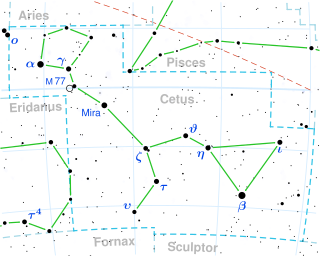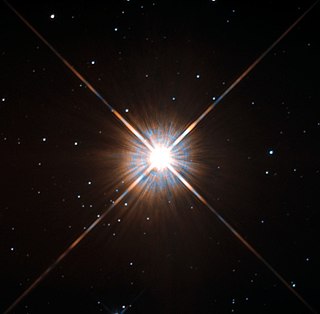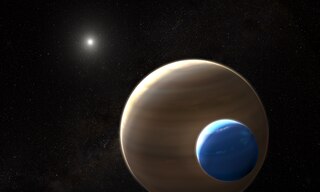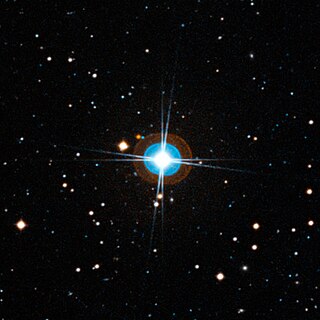
Alpha Centauri is a triple star system in the southern constellation of Centaurus. It consists of three stars: Rigil Kentaurus, Toliman, and Proxima Centauri. Proxima Centauri is the closest star to the Sun at 4.2465 light-years (1.3020 pc).

An exoplanet or extrasolar planet is a planet outside the Solar System. The first possible evidence of an exoplanet was noted in 1917 but was not then recognized as such. The first confirmation of the detection occurred in 1992. A different planet, first detected in 1988, was confirmed in 2003. As of 1 May 2024, there are 5,662 confirmed exoplanets in 4,169 planetary systems, with 896 systems having more than one planet. The James Webb Space Telescope (JWST) is expected to discover more exoplanets, and to give more insight into their traits, such as their composition, environmental conditions, and potential for life.

Tau Ceti, Latinized from τ Ceti, is a single star in the constellation Cetus that is spectrally similar to the Sun, although it has only about 78% of the Sun's mass. At a distance of just under 12 light-years from the Solar System, it is a relatively nearby star and the closest solitary G-class star. The star appears stable, with little stellar variation, and is metal-deficient relative to the Sun.

Proxima Centauri is a small, low-mass star located 4.2465 light-years (1.3020 pc) away from the Sun in the southern constellation of Centaurus. Its Latin name means the 'nearest [star] of Centaurus'. It was discovered in 1915 by Robert Innes and is the nearest-known star to the Sun. With a quiescent apparent magnitude of 11.13, it is too faint to be seen with the unaided eye. Proxima Centauri is a member of the Alpha Centauri star system, being identified as component Alpha Centauri C, and is 2.18° to the southwest of the Alpha Centauri AB pair. It is currently 12,950 AU (0.2 ly) from AB, which it orbits with a period of about 550,000 years.

An exomoon or extrasolar moon is a natural satellite that orbits an exoplanet or other non-stellar extrasolar body.

Margaret Carol "Maggie" Turnbull is an American astronomer and astrobiologist. She received her PhD in Astronomy from the University of Arizona in 2004. Turnbull is an authority on star systems which may have habitable planets, solar twins and planetary habitability. She is also an expert on the use of the coronagraph in the direct detection of exoplanets.

Any planet is an extremely faint light source compared to its parent star. For example, a star like the Sun is about a billion times as bright as the reflected light from any of the planets orbiting it. In addition to the intrinsic difficulty of detecting such a faint light source, the light from the parent star causes a glare that washes it out. For those reasons, very few of the exoplanets reported as of January 2024 have been observed directly, with even fewer being resolved from their host star.

A Super-Earth is a type of exoplanet with a mass higher than Earth's, but substantially below those of the Solar System's ice giants, Uranus and Neptune, which are 14.5 and 17 times Earth's, respectively. The term "super-Earth" refers only to the mass of the planet, and so does not imply anything about the surface conditions or habitability. The alternative term "gas dwarfs" may be more accurate for those at the higher end of the mass scale, although "mini-Neptunes" is a more common term.
This page describes exoplanet orbital and physical parameters.

HD 10180, also designated 2MASS J01375356-6030414, is a Sun-like star in the southern constellation Hydrus that is notable for its large planetary system. Since its discovery, at least six exoplanets have been observed orbiting it, and some studies have proposed up to nine potential planets, which would make it potentially the largest of all known planetary systems, including the Solar System.

An exoplanet is a planet located outside the Solar System. The first evidence of an exoplanet was noted as early as 1917, but was not recognized as such until 2016; no planet discovery has yet come from that evidence. What turned out to be the first detection of an exoplanet was published among a list of possible candidates in 1988, though not confirmed until 2003. The first confirmed detection came in 1992, with the discovery of terrestrial-mass planets orbiting the pulsar PSR B1257+12. The first confirmation of an exoplanet orbiting a main-sequence star was made in 1995, when a giant planet was found in a four-day orbit around the nearby star 51 Pegasi. Some exoplanets have been imaged directly by telescopes, but the vast majority have been detected through indirect methods, such as the transit method and the radial-velocity method. As of 1 May 2024, there are 5,662 confirmed exoplanets in 4,169 planetary systems, with 896 systems having more than one planet. This is a list of the most notable discoveries.

HD 40307 g is an exoplanet candidate suspected to be orbiting in the habitable zone of HD 40307. It is located 42 light-years away in the direction of the southern constellation Pictor. The planet was discovered by the radial velocity method, using the European Southern Observatory's HARPS apparatus by a team of astronomers led by Mikko Tuomi at the University of Hertfordshire and Guillem Anglada-Escude of the University of Göttingen, Germany.

PH2, also known as Kepler-86, or KIC 12735740, is a G-type star 1,120 light-years distant within the constellation Cygnus. Roughly the size and temperature of the Sun, PH2 gained prominence when it was known to be the host of one of 42 planet candidates detected by the Planet Hunters citizen science project in its second data release. The candidate orbiting around PH2, known as PH2b, had been determined to have a spurious detection probability of only 0.08%, thus effectively confirming its existence as a planet.

Kepler-442b is a confirmed near-Earth-sized exoplanet, likely rocky, orbiting within the habitable zone of the K-type main-sequence star Kepler-442, about 1,206 light-years (370 pc) from Earth in the constellation of Lyra.

Proxima Centauri b, sometimes referred to as Alpha Centauri Cb, is an exoplanet orbiting within the habitable zone of the red dwarf star Proxima Centauri, which is the closest star to the Sun and part of the larger triple star system Alpha Centauri. It is about 4.2 light-years from Earth in the constellation Centaurus, making it and Proxima d, along with the currently disputed Proxima c, the closest known exoplanets to the Solar System.

Proxima Centauri c is a controversial exoplanet candidate claimed to be orbiting the red dwarf star Proxima Centauri, which is the closest star to the Sun and part of a triple star system. It is located approximately 4.2 light-years from Earth in the constellation of Centaurus, making it, Proxima b, and Proxima d the closest known exoplanets to the Solar System.
Kepler-1708b is a Jupiter-sized exoplanet orbiting the Sun-like star Kepler-1708, located in the constellation of Cygnus approximately 5,600 light years away from Earth. It was first detected in 2011 by NASA's Kepler mission using the transit method, but was not identified as a candidate planet until 2019. In 2021, a candidate Neptune-sized exomoon in orbit around Kepler-1708b was found by astronomer David Kipping and colleagues in an analysis using Kepler transit data. However, subsequent research has raised discrepancies about the possible existence of an exomoon, similar to that of Kepler-1625b.



















